Research on Conductivity Damage Based on Response Surface Analysis
Abstract
:1. Background
2. Test Equipment and Methods
2.1. Test Experimental Procedure
2.1.1. Test Material
2.1.2. Test Equipment
2.2. Test Methods
2.2.1. Calculation Method of Conductivity Damage
2.2.2. Test of Proppant Conductivity Damage
3. Results and Discussion
3.1. Single Factor Test Results and Discussion
3.1.1. The Influence of Sand Concentration
3.1.2. The Influence of Fracturing Fluid Viscosity
3.1.3. The Influence of Fracturing Fluid Retention Time
3.2. Response Surface Test Result and Discussion
3.2.1. Experimental Results and Analysis of Conductivity Damage Response Surface
3.2.2. Contour and Response Surface Plots
3.3. Fracturing Parameter Optimization Analysis
4. Conclusions
Author Contributions
Funding
Institutional Review Board Statement
Informed Consent Statement
Data Availability Statement
Conflicts of Interest
References
- Ryosuke, K.; Nozomu, Y.; Kei, F. Productivity Improvement by Reperforation of Multistage-Fractured Wells in High-Pressure/High-Temperature Tight Gas Reservoirs: A Case History. SPE Prod. Oper. 2021, 36, 97–115. [Google Scholar]
- Kelvin, A.; John, W.; Derek, E. Laboratory Investigation of Impact of Slickwater Composition on Multiphase Permeability Evolution in Tight Sandstones. In Proceedings of the SPE Low Perm Symposium, Denver, CO, USA, 5–6 May 2016. [Google Scholar]
- Abhinav, M.; Chandra, S.; Carl, H. A Study of Propped-Fracture Conductivity: Impairment Mechanisms Under Laboratory Conditions. In Proceedings of the SPWLA 58th Annual Logging Symposium, Oklahoma City, OK, USA, 17–21 June 2017. [Google Scholar]
- Antonia, S.; Victor, T.; Ulrich, B. Assessment of Polymer-Induced Clogging Using Microfluidics. SPE J. 2021, 26, 3793–3804. [Google Scholar]
- Jesse, G.; Zhu, D.; Hill, A.D. Impairment of Fracture Conductivity in the Eagle Ford Shale Formation. SPE Prod. Oper. 2018, 33, 637–653. [Google Scholar]
- Jansen, T.; Zhu, A.D. The Effect of Rock Mechanical Properties on Fracture Conductivity for Shale Formations. In Proceedings of the SPE Hydraulic Fracturing Technology Conference, The Woodlands, TX, USA, 3–5 February 2015. [Google Scholar]
- Aadtiya, K.; Ruud, W. Distinguishing Fracture Conductivity and Fracture Flux: A Systematic Investigation of Individual Fracture Contribution to Well Productivity. In Proceedings of the SPE/AAPG/SEG Unconventional Resources Technology Conference, Virtual, 20–22 July 2020. [Google Scholar]
- Zhang, J.J.; Ouyang, L.; Hill, A.D. Experimental and Numerical Studies of Reduced Fracture Conductivity due to Proppant Embedment in Shale Reservoirs. In Proceedings of the SPE Annual Technical Conference and Exhibition, Amsterdam, The Netherlands, 27–29 October 2014. [Google Scholar]
- Yeten, B.; Castellini, A.; Guyaguler, B. A Comparison Study on Experimental Design and Response Surface Methodologies. In Proceedings of the SPE Reservoir Simulation Symposium, The Woodlands, TX, USA, 31 January–2 February 2005. [Google Scholar]
- Myers, R.; Montgomery, D.; Anderson-Cook, C. Response Surface Methodology: Process and Product Optimization Using Designed Experiments. Technometrics 1996, 38, 285. [Google Scholar]
- Shusei, T.; Tsubasa, O.; Dongjae, K. Application of Combined Streamline Based Reduced-Physics Surrogate and Response Surface Method for Field Development Optimizaion. In Proceedings of the International Petroleum Technology Conference, Dhahran, Saudi Arabia, 13 January 2020. [Google Scholar]
- Xiaodong, K.; Baozhen, L.; Jian, Z. Optimization of the SAGP Process in L Oil-Sand Field with Response Surface Methodology. In Proceedings of the Abu Dhabi International Petroleum Exhibition & Conference, Abu Dhabi, United Arab Emirates, 11–14 November2019. [Google Scholar]
- Yuan, X.; Xu, D.J.; Chen, S.H. The damage of fracturing fluid intrusion to the conductivity of shale reservoir. Sci. Technol. Eng. 2020, 20, 3591–3597. [Google Scholar]
- Liang, T.; Cai, B.; Meng, C. The effect of proppant performance of hydraulic fracturing on conductivity. Fault-Block Oil Gas Field 2021, 28, 403–407. [Google Scholar]
- Sarvesh, N.; Amit, S. Impact of Fracture Conductivity on Production: How Much Proppant do We Really Need in Unconventional Reservoirs? In Proceedings of the SPE/AAPG/SEG Unconventional Resources Technology Conference, Houston, TX, USA, 16–18 November 2021. [Google Scholar]
- Zou, Y.; Shi, S.; Zhang, S. Experimental modeling of sanding fracturing and conductivity of propped fractures in conglomerate: A case study of tight conglomerate of Mahu sag in Junggar Basin, NW China. Pet. Explor. Dev. 2021, 48, 1202–1209. [Google Scholar] [CrossRef]
- Abhishek, G.; Chandra, R.; Carl, S. Experimental Investigation of Propped Fracture Conductivity and Proppant Diagenesis. In Proceedings of the SPE/AAPG/SEG Unconventional Resources Technology Conference, Denver, CO, USA, 22–24 July 2019. [Google Scholar]
- Liu, X. Influencing factors of hydraulic propped fracture conductivity in shale reservoir. Fault-Block Oil Gas Field 2020, 27, 394–398. [Google Scholar]
- Ahmed, E.; Hisham, A. Propped Fracture Conductivity in Shale Reservoirs: A Review of Its Importance and Roles in Fracturing Fluid Engineering. In Proceedings of the SPE Kingdom of Saudi Arabia Annual Technical Symposium and Exhibition, Dammam, Saudi Arabia, 23–26 April 2018. [Google Scholar]
- Ming, F.; Yan, H.; James, M. Hydraulic Fracture Conductivity as a Function of Proppant Concentration Under Various Effective Stresses: From Partial Monolayer to Multilayer Proppants. In Proceedings of the SPE/AAPG/SEG Unconventional Resources Technology Conference, Austin, TX, USA, 24–26 July 2017. [Google Scholar]

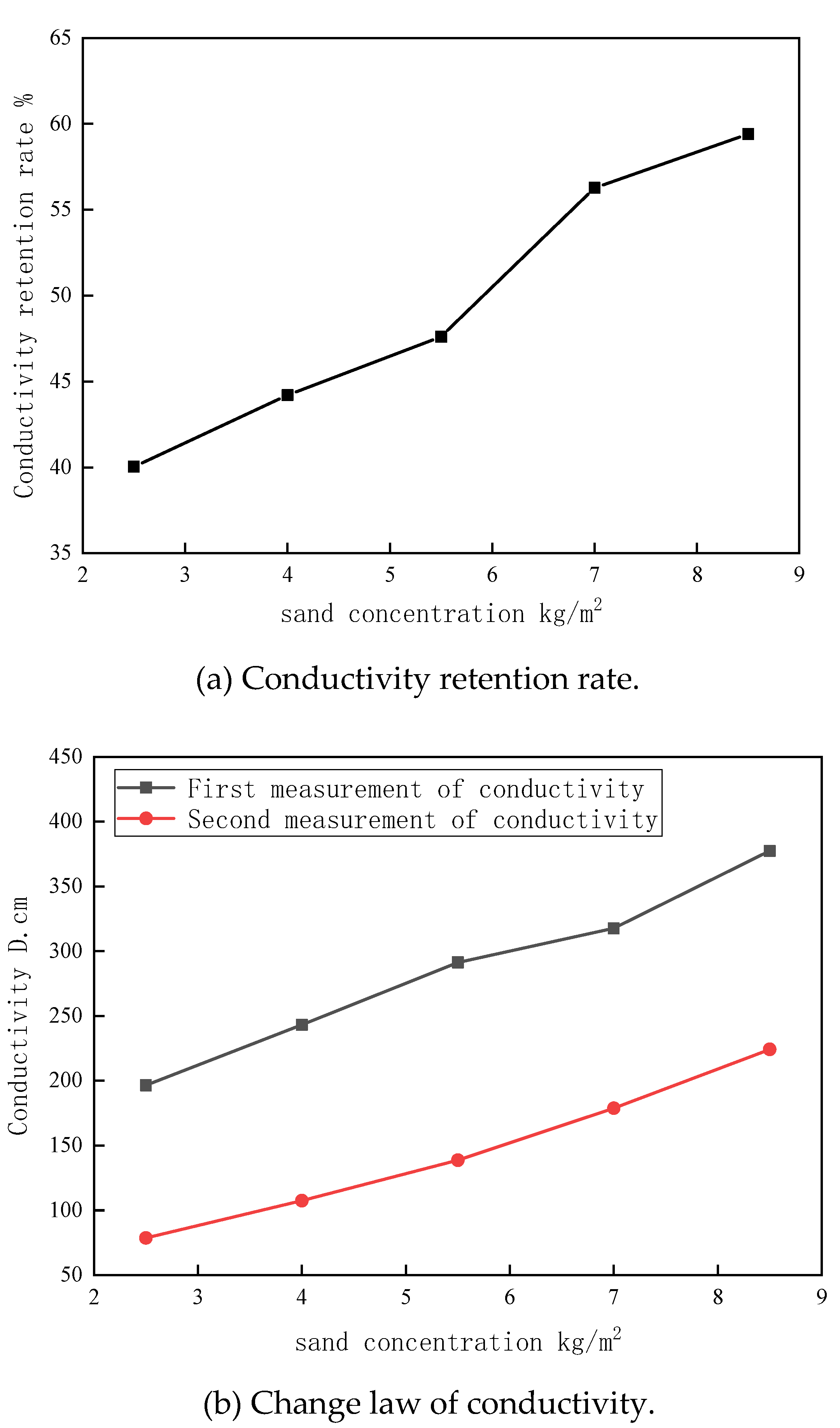
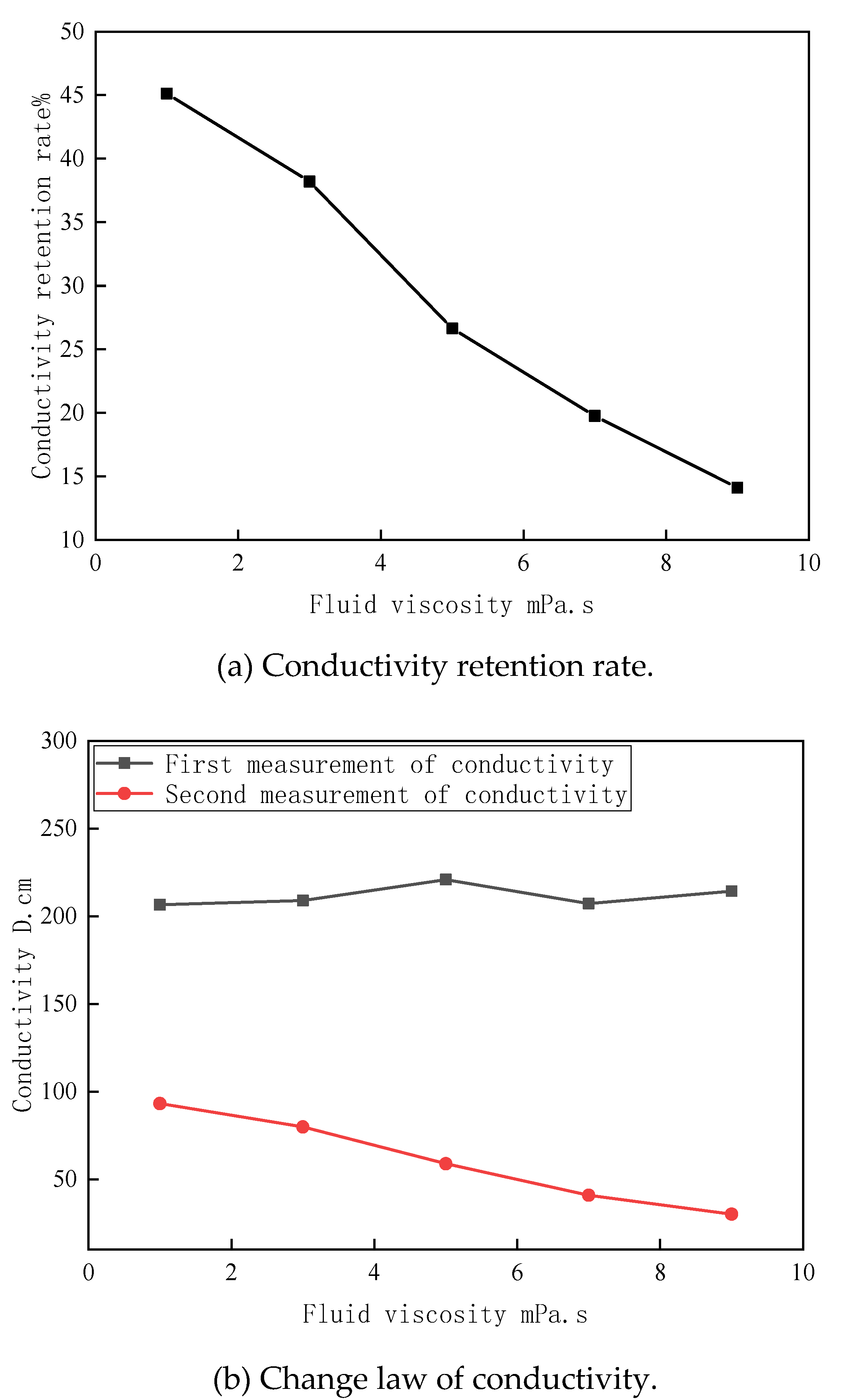
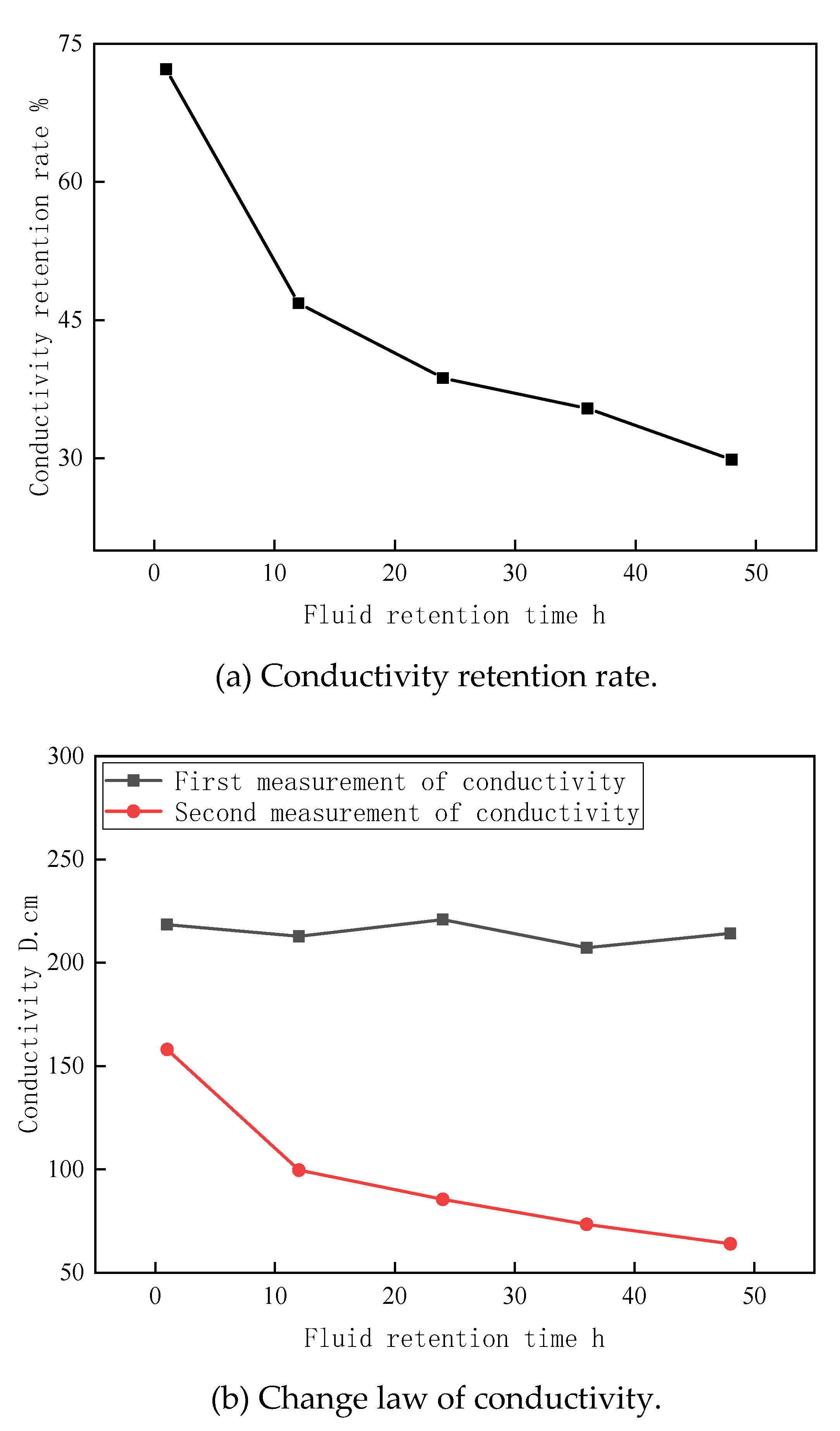

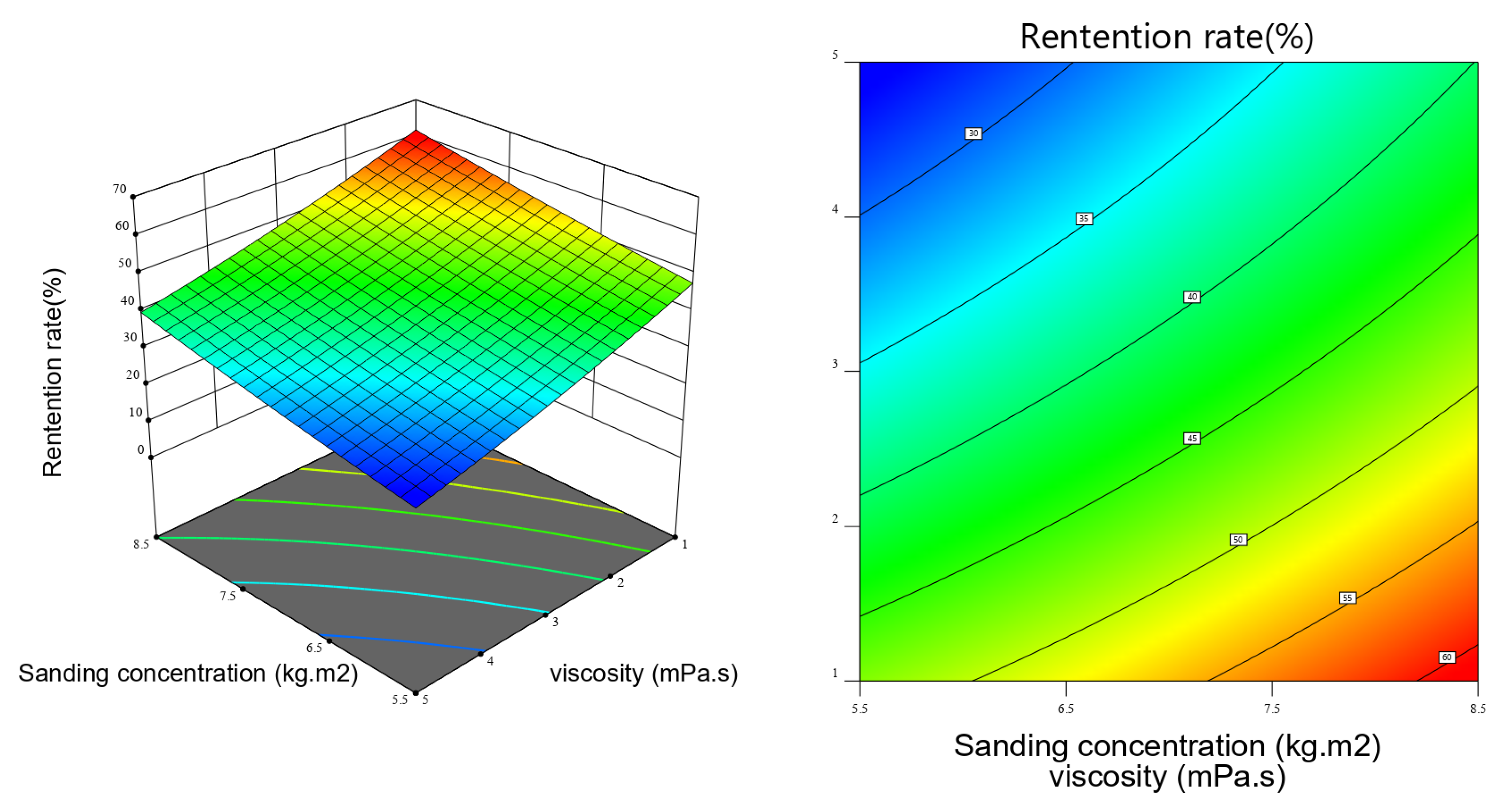
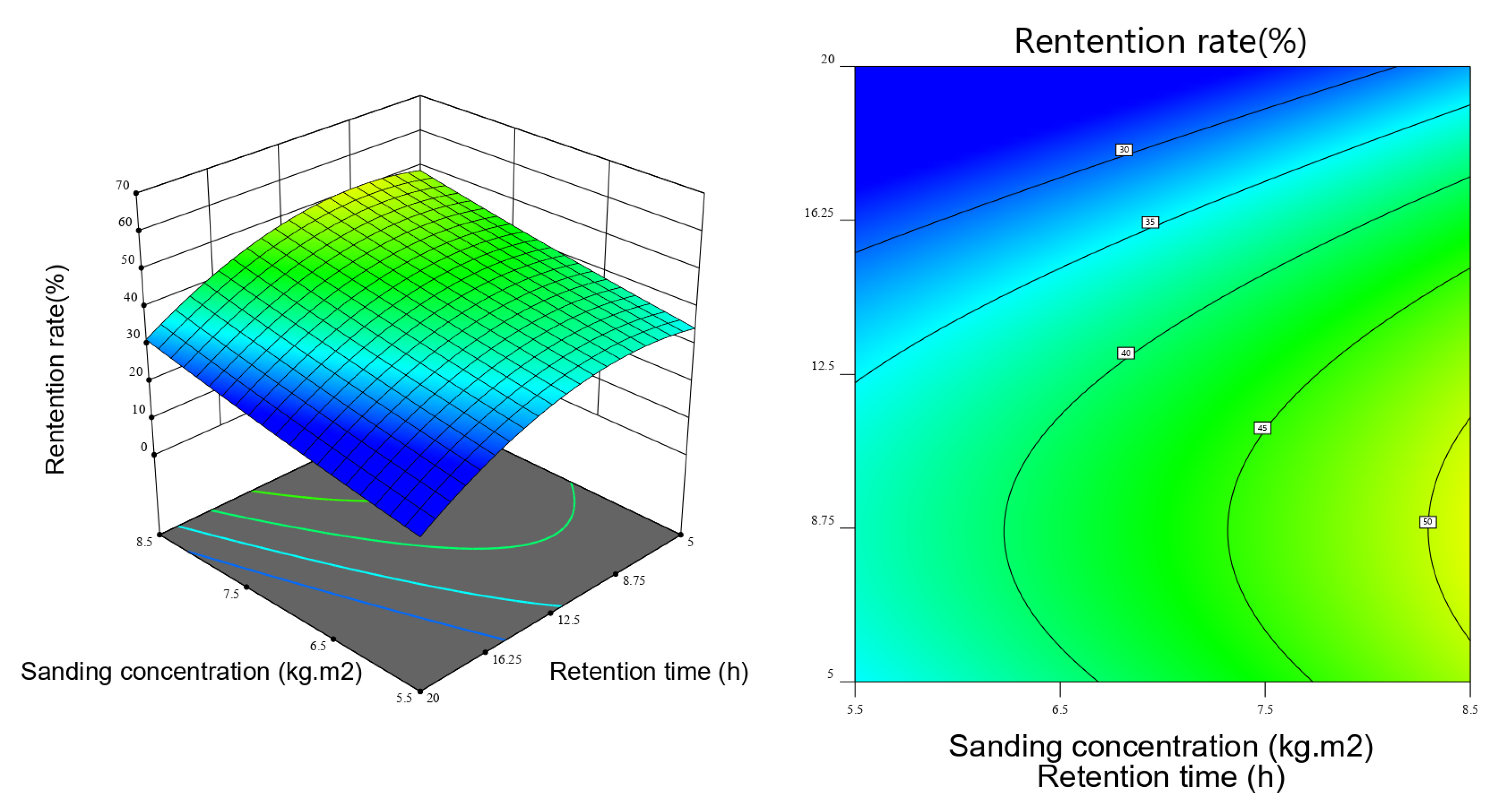

| Number | Sand Concentration (kg/m2) | Fracturing Fluid Viscosity (mPa.s) | Fracturing Fluid Retention Time (h) |
|---|---|---|---|
| 1–5 | 2.5, 4, 5.5, 7, 8.5 | 1 | 12 |
| 6–10 | 5.5 | 1, 3, 5, 7, 9 | 12 |
| 10–15 | 5.5 | 1 | 1, 12, 24, 36, 48 |
| Level | Sand Concentration (kg/m2) | Fluid Viscosity (mPa.s) | Fluid Retention Time (h) |
|---|---|---|---|
| −1 | 5.5 | 1 | 10 |
| 0 | 7 | 3 | 12 |
| 1 | 8.5 | 5 | 14 |
| Number | Sand Concentration (kg/m2) | Fluid Viscosity (mPa.s) | Fluid Retention Time (h) | Conductivity Retention Rate (%) |
|---|---|---|---|---|
| 1 | 7 | 3 | 12 | 43.03 |
| 2 | 7 | 3 | 12 | 39.96 |
| 3 | 5.5 | 1 | 12 | 47.61 |
| 4 | 7 | 3 | 12 | 42.38 |
| 5 | 8.5 | 3 | 14 | 47.43 |
| 6 | 7 | 1 | 10 | 56.53 |
| 7 | 7 | 5 | 10 | 32.89 |
| 8 | 7 | 1 | 14 | 51.71 |
| 9 | 8.5 | 1 | 12 | 60.59 |
| 10 | 8.5 | 3 | 10 | 51.08 |
| 11 | 5.5 | 5 | 12 | 26.43 |
| 12 | 7 | 3 | 12 | 41.85 |
| 13 | 5.5 | 3 | 14 | 32.46 |
| 14 | 7 | 3 | 12 | 41.88 |
| 15 | 8.5 | 5 | 12 | 40.34 |
| 16 | 7 | 5 | 14 | 29.11 |
| 17 | 5.5 | 3 | 10 | 36.21 |
| Factor | Sum of Squares | Df | Mean Square | F-Value | p-Value |
|---|---|---|---|---|---|
| Model | 1405.98 | 9 | 156.22 | 116.31 | <0.0001 |
| A | 402.26 | 1 | 402.26 | 299.50 | <0.0001 |
| B | 960.89 | 1 | 960.89 | 715.43 | <0.0001 |
| C | 31.94 | 1 | 31.94 | 23.78 | 0.0018 |
| AB | 0.2146 | 1 | 0.2146 | 0.1598 | 0.7013 |
| AC | 0.0023 | 1 | 0.0023 | 0.0017 | 0.9684 |
| BC | 0.2725 | 1 | 0.2725 | 0.2029 | 0.6660 |
| A2 | 1.39 | 1 | 1.39 | 1.04 | 0.3422 |
| B2 | 7.59 | 1 | 7.59 | 5.65 | 0.0490 |
| C2 | 1.53 | 1 | 1.53 | 1.14 | 0.3213 |
| Residual | 9.40 | 7 | 1.34 | ||
| Lack of Fit | 4.17 | 3 | 1.39 | 1.06 | 0.4585 |
Publisher’s Note: MDPI stays neutral with regard to jurisdictional claims in published maps and institutional affiliations. |
© 2022 by the authors. Licensee MDPI, Basel, Switzerland. This article is an open access article distributed under the terms and conditions of the Creative Commons Attribution (CC BY) license (https://creativecommons.org/licenses/by/4.0/).
Share and Cite
Pan, Y.; Yang, Z.; Pan, Y.; Xu, Y.; Liao, R. Research on Conductivity Damage Based on Response Surface Analysis. Energies 2022, 15, 2818. https://doi.org/10.3390/en15082818
Pan Y, Yang Z, Pan Y, Xu Y, Liao R. Research on Conductivity Damage Based on Response Surface Analysis. Energies. 2022; 15(8):2818. https://doi.org/10.3390/en15082818
Chicago/Turabian StylePan, Yuan, Ze Yang, Yuting Pan, Yiwen Xu, and Ruiquan Liao. 2022. "Research on Conductivity Damage Based on Response Surface Analysis" Energies 15, no. 8: 2818. https://doi.org/10.3390/en15082818
APA StylePan, Y., Yang, Z., Pan, Y., Xu, Y., & Liao, R. (2022). Research on Conductivity Damage Based on Response Surface Analysis. Energies, 15(8), 2818. https://doi.org/10.3390/en15082818






